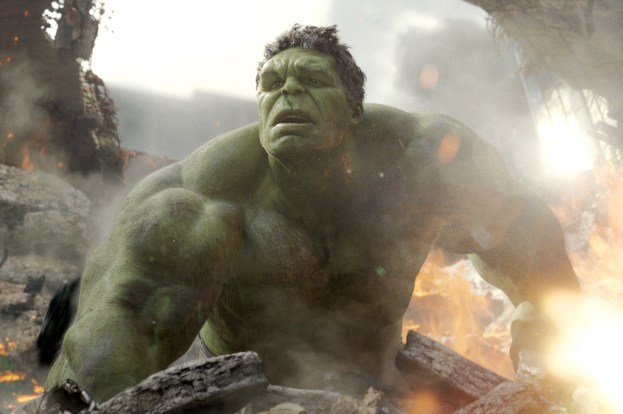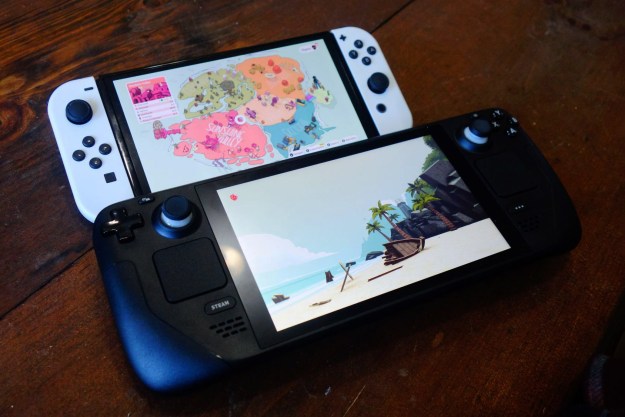
|
As in previous years, five films are nominated for an Academy Award in the “Visual Effects” category, and they each offer a nice look at the amazing tricks filmmakers and their effects teams can pull off on the big screen. In recognition of these five films and one of our favorite Oscar categories, we’re putting the spotlight on one “Visual Effects” nominee each day leading up to Sunday’s broadcast. Previously, we looked at The Hobbit: An Unexpected Journey and director Peter Jackson’s controversial decision regarding the shooting speed for the movie. Now we turn our attention to The Avengers, Marvel’s superhero team-up blockbuster featuring Iron Man, Thor, Captain America, and Hulk joining forces to battle a threat greater than anything they can handle alone. |

On top of the film’s considerable box-office achievements, it also managed to accomplish something else no one expected: It reinvigorated interest in Marvel’s green-skinned goliath, Hulk.
Before teaming up with Iron Man, Thor, and the rest of the Avengers, Hulk smashed his way through not one, but two big-screen flops. Neither 2003’s Hulk directed by Ang Lee nor Louis Leterrier’s 2008 reboot The Incredible Hulk managed to make a box-office star out of Bruce Banner or his raging alter ego, making all the critical and fan praise for his role in Avengers all the more surprising.
Given the character’s heavy reliance on visual effects, The Avengers‘ nomination in that category makes Hulk the perfect ambassador for the film’s technical achievements, and just the right element to focus on when looking at what earned the film its Oscar nomination.
So, how did Marvel build a better Hulk? The answer might lie in the evolution of the character from his first bow in 2012 to the raging behemoth that saved the world in The Avengers.

While Lee’s cerebral take on Hulk premiered way back in 2003, the jade giant’s solo film had been in the works for nearly 12 years as the studio waited for digital-effects technology to reach a point when such a project was even remotely viable. Undertaken by George Lucas’ effects studio Industrial Light & Magic, bringing Hulk to life on the big screen was one of the company’s most taxing projects up to that point, requiring the participation of nearly 200 technicians over 1.5 years to create the version of Hulk that eventually appeared on the screen.
An entirely computer-generated character, the Hulk of the 2003 movie was intended to reproduce actual human movements, with personal trainers (not bodybuilders) serving as the models for various actions. The ILM animators used similar technology to that which was used to bring the elf Dobby to life in Harry Potter and the Chamber of Secrets, and a cardboard standup was used during most scenes with live actors to indicate where Hulk would be located in the finished scene.
Hulk star Eric Bana, who played Hulk’s mild-mannered alter ego Bruce Banner, told Empire Magazine in May 2003 that Lee compared the live portion of production to a Greek tragedy, while indicating that a “whole other movie” about Hulk was being created at ILM.
… the studio also opted to base this new version of Hulk on football linebackers instead of personal trainers…
Cut to 2008 and Marvel’s decision to roll the dice on their green giant again, and there’s a new face for Bruce Banner – Fight Club actor Edward Norton – and a new studio tasked with making Hulk a more lifelike, believable character on the screen. This time around, a blend of motion-capture and animation were used by effects studio Rhythm & Hues, with director Leterrier pushing to bring the man and the monster closer together by using more of the former and less of the computer-generated latter whenever possible.
Along with shifting their approach a bit, the studio also opted to base this new version of Hulk on football linebackers instead of personal trainers, using motion-capture technology to mimic their fast, brutal, and aggressive movements. Norton and co-star Tim Roth, who played the equally monstrous CGI villain Abomination in the film, also got in on the action by filming more than 2,500 different takes of their characters’ movements in front of 37 digital cameras. The pair also used phosphorescent paint and lighting techniques to record some of their facial expressions and mannerisms, with Leterrier aping (no pun intended) Andy Serkis’ style of bringing Gollum and King Kong to life in The Lord of the Rings franchise and King Kong, respectively.
Along with making this version of the CGI-driven Hulk more expressive facially, significant attention was paid to the way Hulk’s muscles and skin reacted to both internal and external elements throughout the film, with computer programs created to mimic inflation of muscles and the flushing of skin.

Though this version of Hulk seemed to address many of the issues critics and fans had with the 2003 model, The Incredible Hulk still failed to win over audiences at the box office, reaping only marginally better ticket sales than its predecessor. Despite generally positive reviews, Hulk’s climactic battle with Abomination was cited as one of the elements that relied too heavily on digital effects, with much of their clash lost in a whirlwind of computer-generated carnage. Even so, the film was almost universally praised as an improvement on 2003’s Hulk — most noticeably in the look and tone of Hulk.
Given the lukewarm reception Hulk had received up to that point, it’s no surprise that expectations were low for the character’s return to the screen in The Avengers four years later.
“No one’s ever played the Hulk exactly; they’ve always done CGI…”
“We really wanted to utilize everything we’ve developed the last 10 years and make it a pretty spectacular Hulk,” said Jeff White, ILM’s visual effects supervisor, in a May 2012 interview with Animation World Network. “One of the great design decisions was to incorporate Mark Ruffalo into the look of him. So, much of Hulk is based on Ruffalo and his performance, not only in motion capture and on set, but down to his eyes, his teeth, and his tongue.”

Unlike previous iterations of the character, the version of Hulk seen in The Avengers also featured Ruffalo’s facial likeness – an extra level of detail insisted upon by the studio and director Joss Whedon. (Hulk’s body was modeled on a bodybuilder and male stripper named Steve Romm, however.)
“I’m really excited,” Ruffalo told New York Magazine ahead of the film’s release. “No one’s ever played the Hulk exactly; they’ve always done CGI. They’re going to do the Avatar stop-action, stop-motion capture. So I’ll actually play the Hulk. That’ll be fun.”
And fun it was – both for Ruffalo and for Avengers audiences around the world.
Now the icing on the cake would seem to be the Oscar nod the film has received, which is as much a nod to Hulk as a supporting actor as it is to the technical achievements that brought him to the screen. So, after smashing a vengeful god and defeating an invading horde of aliens, this weekend sees the Hulk matching up against his toughest opponent yet: the voters who make up The Academy of Motion Picture Arts and Sciences.



